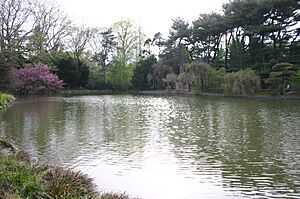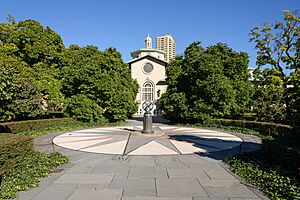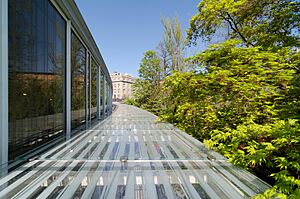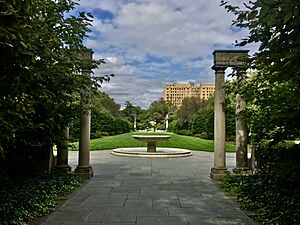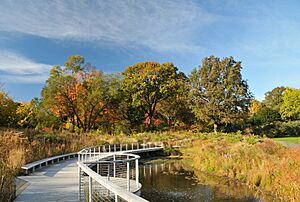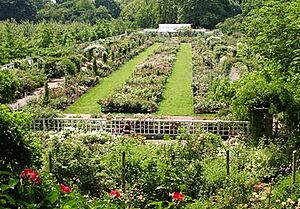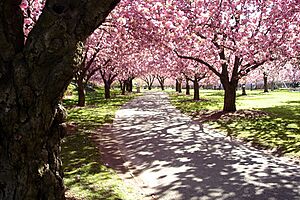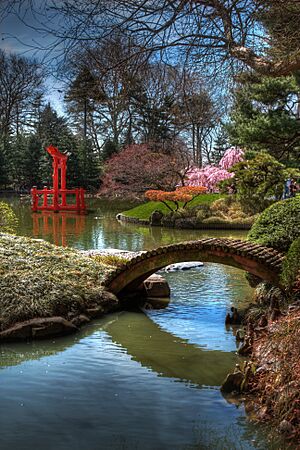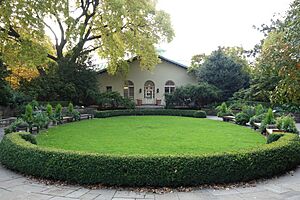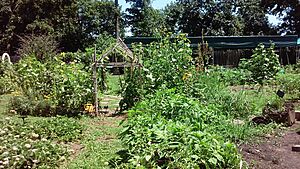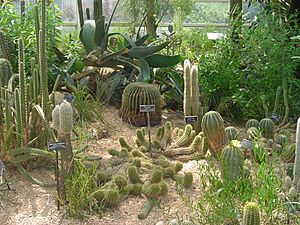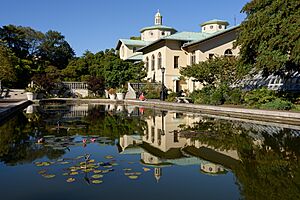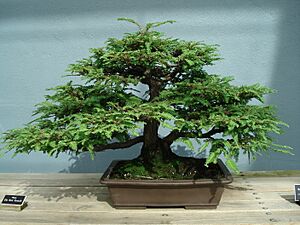Brooklyn Botanic Garden facts for kids
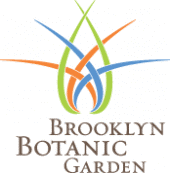
Current logo
|
|
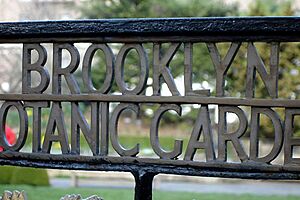
Brooklyn Botanic Garden
|
|
| Date opened | May 13, 1911 |
|---|---|
| Location | 990 Washington Avenue, Crown Heights, Brooklyn, New York 11225 United States |
| Land area | 52 acres (21 ha) |
| Coordinates | 40°40′12″N 73°57′45″W / 40.67000°N 73.96250°W |
| No. of species | 14,000 |
| Annual visitors | 800,000 (2015) |
The Brooklyn Botanic Garden (BBG) is a beautiful botanical garden located in Brooklyn, New York City. It covers 52 acres (21 ha) and is home to over 14,000 different kinds of plants. More than 800,000 people visit the garden each year.
The garden was designed by the famous Olmsted Brothers. It features many special gardens, plant collections, and buildings. BBG also offers educational programs, works on plant science and conservation, and helps with community gardening.
The idea for the Brooklyn Botanic Garden started in 1897. It officially opened in May 1911 on what used to be an ash dump. Most of the garden's growth happened in its first 30 years. Starting in the 1980s, the garden was greatly expanded and improved. New buildings were added through the 2010s.
BBG's landscape includes many unique gardens. A small brook flows from the Japanese Hill-and-Pond Garden to the Water Garden. Other special areas include rose, native plant, Shakespeare, fragrance, and children's gardens. There are also formal areas like the Cherry Esplanade. The garden's buildings include the Steinhardt Conservatory, the Laboratory Administration Building, and a palm house.
Contents
History of the Garden
Early Ideas for a Garden
Before the Brooklyn Botanic Garden was built, there were other ideas for gardens in Brooklyn. One garden, created by André Parmentier, existed from 1825 to 1830. Another plan in 1855 for the Hunt Horticultural and Botanical Garden never happened.
A third idea for a garden was part of the plans for Prospect Park in 1859. The garden was supposed to be near the park's lake. However, the American Civil War stopped these plans. The land where BBG now stands was an ash dump for many years.
How BBG Was Created
Getting Started and Funding
In 1897, the New York State Legislature set aside 39 acres (16 ha) for a botanic garden. This land became part of Institute Park in 1902. The garden was to be managed by the Brooklyn Institute of Arts and Sciences.
In 1905, some donors offered $25,000 to help maintain a "scientific botanic garden." This amount doubled to $50,000 the next year. City officials supported the idea in 1907. Alfred Tredway White, a trustee, leased 40 acres from the city for the garden.
In 1909, the Olmsted Brothers were hired to design the landscape. McKim, Mead & White were chosen as architects for the buildings. The city and the Brooklyn Institute signed an agreement to maintain the garden in December 1909. C. Stuart Gager became BBG's first director in March 1910.
Building and Opening the Garden
Gager wanted BBG to be like "an animated textbook in botany." It would have a Palm House and laboratories. The Olmsted Brothers also wanted the garden to be beautiful, not just organized by plant types.
The first part of BBG, the Native Flora Garden, opened on May 13, 1911. This date was chosen to honor the naturalist Carl Linnaeus. At first, the plants had temporary labels. Work on the Palm House and laboratory had not yet begun.
Harold Caparn became the landscape architect in 1912. Construction of the Laboratory Administration Building started in April 1912. The city gave BBG an extra 3 acres of land that September.
The first parts of the Laboratory Administration Building and the Palm House opened in December 1913. The Palm House had about 250 plant types. In 1914, BBG started a children's garden, one of the first in the world. By the end of that year, a Japanese garden and a rock garden were being built.
BBG's Japanese garden opened in June 1915. The garden began admitting visitors every day. The rock garden was finished in May 1916. The Laboratory Administration Building and Palm House were mostly complete in early 1917. They were officially opened in April 1917. The children's building was also finished that year.
How BBG Has Grown (1920s-Present)
Early Years of Operation
By the early 1920s, BBG had 330,000 visitors a year. In 1925, John D. Rockefeller Jr. offered to donate $250,000 if BBG could raise matching funds. That same year, Ernest F. Coe donated 32 bonsai trees, starting the Bonsai Collection. A Shakespeare garden opened in May 1925.
The Cranford Rose Garden opened in June 1928, thanks to a donation from Walter V. Cranford. An anonymous donor helped build a stone bridge over the garden's lake in December 1928.
In 1929, an ornamental gate was installed at the Flatbush Avenue entrance. The Japanese garden was expanded and reopened in 1931.
Changes in the 1930s and 1940s
In 1933, the redesigned native wildflower garden and the plaza in front of the Laboratory Administration Building were finished. Workers from the Civil Works Administration helped landscape a new area next to the Brooklyn Museum. This new area was mostly completed in 1935.
The Cherry Esplanade was created in 1941 with cherry trees donated by the Women's Auxiliary. The Japanese Hill-and-Pond Garden was closed from 1941 to 1947 due to anti-Japanese feelings during World War II. C. Stuart Gager, the first director, passed away in 1943. George S. Avery Jr. became the new director in 1944.
Mid-Century Developments
In the early 1950s, Avery planned to expand the children's garden. In 1954, the Women's Auxiliary suggested creating a "garden of fragrance" for people with vision impairment. This garden opened in June 1955.
Elizabeth Van Brunt sold 223 acres of forest in Westchester County to BBG in 1956 for a research center. BBG also restored its paths and added new trees in 1958.
Challenges and Changes (1960s-1970s)
A Shinto shrine was dedicated in BBG's Japanese Garden in May 1960. By October of that year, BBG had welcomed 50 million visitors in total. A replica of a stone garden from Ryōan-ji was dedicated in May 1963.
The Native Flora Garden closed in 1963 due to lack of money and did not reopen for 20 years. By the mid-1960s, BBG's finances were struggling. Crime also increased, leading to the closure of many garden exits.
Elizabeth Scholtz became BBG's fourth director in 1973, the first woman to lead a major U.S. botanical garden. BBG separated from the Brooklyn Institute in the 1970s. Due to financial issues, BBG started closing on Mondays in 1975. The Shakespeare Garden reopened in June 1979 after being moved.
Growth and Renovations (1980s-1990s)
Donald E. Moore became BBG's director in 1980. Under his leadership, BBG grew, and its membership tripled. BBG started hosting events like parties and weddings in 1982. The annual cherry blossom festival also began that year.
In 1983, the native flora garden reopened. By the mid-1980s, BBG had over 600,000 visitors each year. The Palm House and wooden greenhouses were in bad condition.
In 1984, BBG announced plans to build a new conservatory and restore the Palm House for $16 million. The Steinhardt Conservatory, named after Michael and Judith Steinhardt, opened on May 19, 1988. The Palm House was turned into an education center. A gift shop and a discovery center also opened in 1989.
Judith Zuk became BBG's president in 1990. Several gardens were renovated during her time. The Discovery Garden opened in September 1992. In 1996, the garden started charging a $3 admission fee for adults due to funding cuts. The Japanese Hill-and-Pond Garden was renovated starting in 1999 and reopened in May 2000.
Recent Years (2000s to Present)
The entrance on Eastern Parkway was rebuilt in 2003 and opened in 2005. After Zuk retired in 2005, Scot Medbury became president. The Cranford Rose Garden was restored in 2006, and the C.V. Starr Bonsai Museum in 2007.
BBG's Laboratory Building was named a city landmark in 2007. In 2009, BBG announced plans for a new entrance and visitor center on Washington Avenue. The visitor center opened in May 2012. An expansion of the Native Flora Garden opened in June 2013.
In 2014, Brooklyn Botanic Garden received the National Medal for Museum and Library Service. The Discovery Garden reopened in June 2015 after a renovation. The Water Garden, named for Shelby White and Leon Levy, reopened in September 2016. The Yellow Magnolia Café opened in the Palm House in 2017.
In 2018, the Robert W. Wilson Overlook was rededicated. The Elizabeth Scholtz Woodland Garden also opened that year. BBG protested a high-rise tower project next to the garden in 2019, and the project was canceled.
BBG was temporarily closed from March to August 2020 due to the COVID-19 pandemic in New York City. Adrian Benepe became BBG's president in late 2020. In 2024, the retailer Anthropologie opened a Terrain store at BBG. A new apartment building project near BBG was proposed again in the 2020s.
Location and Features
The Brooklyn Botanic Garden is in central Brooklyn, near the neighborhoods of Park Slope, Prospect Heights, and Crown Heights. It shares a large city block with the Brooklyn Public Library, Mount Prospect Park, and the Brooklyn Museum. BBG covers 52 acres (21 ha), making it smaller than the New York Botanical Garden. As of August 2025, BBG has 9,250 unique types of plants.
About 17,000 years ago, a glacier formed hills and valleys in this area. Mount Prospect, near Flatbush Avenue, is one of Brooklyn's tallest hills. Many rocks from the glacier were found on the site. These boulders were used in the rock garden, native flora garden, and bridges.
A brook flows through the garden, starting in the Japanese Hill-and-Pond Garden and ending in the Shelby White and Leon Levy Water Garden. Since 2019, water from the Water Garden is recycled back to the Japanese Garden. This saves a lot of water each year.
Entrances
Brooklyn Botanic Garden has three entrances. The southwest entrance, on Flatbush Avenue, has an Italian Renaissance Revival-style gate. This gate is 20 feet (6.1 m) tall and 23 feet (7.0 m) wide, made of brick and limestone. It has three arches. A visitor center was added near this entrance.
The northern entrance on Eastern Parkway was rebuilt in 2003. It has a 16-foot-wide (4.9 m) stainless-steel gate and 12-foot-high (3.7 m) curved steel walls. It also features a 50-foot-high (15 m) cast-glass cone.
The eastern entrance on Washington Avenue has the Diane H. and Joseph S. Steinberg Visitor Center. This building has a sloped green roof covering 10,000 square feet (930 m2). It is heated by a special ground source heat pump system.
Special Gardens and Collections
Osborne Garden
At the north end of BBG is the Osborne Garden, a 3-acre (1.2 ha) Italian-style garden. It has pergolas, a memorial with four columns, a fountain, and seats. The columns are 35 feet (11 m) high. The benches around the fountain are called "whispering chairs" because you can hear whispers from far away.
Native Flora Garden
The Native Flora Garden is in BBG's northwest corner. It was the first of its kind in North America. It was redesigned in 1931 to show plants native to the New York area. The garden was closed from 1963 to 1983.
The garden has different "ecological zones" like a bog, a wet meadow, and a woodland. It was expanded in the 2000s and 2010s. The newer design includes a tallgrass prairie and a wooden bridge. There are over 15,000 plants in this garden.
Cranford Rose Garden
The Cranford Rose Garden is in the northern part of BBG. It is named after Walter V. Cranford, who donated money for it. The garden was designed by Harold Caparn and Montague Free. It originally had 15 beds with 3,000 roses.
In the late 20th century, it was the third-largest public rose garden in the U.S. It had 5,000 bushes and 900 varieties of roses. As of the early 21st century, it still has many of its original plants. The garden features many types of roses, including the 'Knock Out' rose and the 'Julia Child' rose.
Cherry Walk and Cherry Esplanade
Brooklyn Botanic Garden has over 200 cherry trees, with 42 different Asian types. These trees bloom from late March or early April to mid-May. The Cherry Walk connects the pond to the Cherry Esplanade.
The Cherry Esplanade has two rows of tall cherry trees and several rows of shorter ones. There are 76 trees of 21 varieties. A limestone fountain is in the esplanade. The southern end has the Rose Arc Pool with three beds of roses.
Japanese Hill-and-Pond Garden
BBG's Japanese Hill-and-Pond Garden is in the northeast corner. It was one of the first Japanese gardens in an American botanic garden. It was built for $13,000, donated by Alfred Tredway White. The garden was created by Japanese designer Takeo Shiota.
The 3-acre (1.2 ha) garden has three man-made hills, a waterfall, an island, and rocks. It also has a curved pond, wooden bridges, stone lanterns, a viewing pavilion, a torii (gateway), and a Shinto shrine. The pond is full of Japanese koi fish. The center of the pond has Turtle Island with a granite lantern. There is also a Japanese temple dedicated to Inari.
The shrine and viewing pavilion were rebuilt in the 1960s after burning down. The Japanese Garden was restored in 2000.
Shakespeare Garden
BBG's Shakespeare Garden was funded by Henry Clay Folger. It was moved in 1979. This English cottage garden has over 80 plants mentioned in William Shakespeare's plays and poems. Plants are labeled with their names and quotes from Shakespeare.
Alice Recknagel Ireys Fragrance Garden
Next to the Shakespeare Garden is the Fragrance Garden. It was designed by Alice Recknagel Ireys. This was the first garden in the U.S. made for people with vision impairment. It has braille signs. Visitors can touch the fragrant or textured leaves.
The garden has four sections: plants to touch, plants with scented leaves, plants with fragrant flowers, and kitchen herbs. It is wheelchair-accessible, and all plant beds are high enough to reach. There is also a fountain for washing hands.
Children's Garden
The Children's Garden, in the southeast corner, is one of the world's oldest children's gardens. It was started by BBG educator Ellen Eddy Shaw. Children learn to grow vegetables here.
Historically, 200 to 300 children learned gardening each season. As of the 2010s, 1,000 young people visit each year. It is open to interns and children aged 2 to 17. It also has a compost area.
Herb Garden
The Herb Garden, on the western side, has fruit trees, corn, cabbages, and other medicinal and food plants. It includes 300 herb plants. Two knot-shaped hedges are mixed with the herbs.
Discovery Garden
The Discovery Garden is designed for children. It is in the southwest corner, near the Flatbush Avenue entrance. It covers about 1 acre (0.40 ha) and has 250 trees and many other plants. It has meadows, marshes, and woodlands. The garden includes a boardwalk and exhibits for children.
Water Garden
The Shelby White and Leon Levy Water Garden is in the south-central part of BBG. It is a 1.5-acre (0.61 ha) wetland with many sustainable features. It has a pond where the brook from the Japanese Garden ends. The Water Garden was renovated in 2016.
Other Gardens and Features
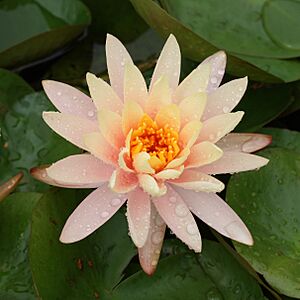
The Lily Pool Terrace, in front of the Laboratory Administration Building, has two large pools with lilies and koi fish. The Elizabeth Scholtz Woodland Garden, in the northwest corner, looks like a forest in the Northeastern U.S. The Louisa Clark Spencer Lilac Collection has 150 lilac bushes. The Rock Garden has alpine plants around 18 large boulders left by glaciers.
The Plant Family Collection, in the center of BBG, shows plants arranged by their family to explain how they evolved. This collection is spread throughout the garden.
A Celebrity Path honors famous Brooklynites like Barbra Streisand and Walt Whitman. It has engraved paving stones. As of August 2025, there are 151 names on the path.
BBG also has the Robert W. Wilson Overlook on its northern border. This overlook is on a hill made from dirt dug up from the nearby Brooklyn Museum site. The overlook is 26 feet (7.9 m) higher than the rest of BBG. It has over 40,000 plants.
Buildings
Most of Brooklyn Botanic Garden's buildings are on the eastern side. These include the Steinhardt Conservatory, the Laboratory Administration Building, the Palm House, and a building for the Children's Garden.
Steinhardt Conservatory
The Steinhardt Conservatory is in the eastern part of BBG. It has four structures: a main building and three octagonal pavilions. These buildings are up to 60 feet (18 m) tall and cover 40,000 square feet (3,700 m2). They are connected by tunnels. The outside is covered with 60,000 square feet (5,600 m2) of glass panes.
The main building has a bonsai museum, an aquatic greenhouse, and the Trail of Evolution exhibit. The C. V. Starr Bonsai Museum has the second-oldest collection of bonsai in the U.S. The Robert W. Wilson Aquatic House has tropical water plants, insect-eating plants, and orchids. The Trail of Evolution shows how plants have changed over 3.5 billion years.
The three octagonal pavilions are themed to different climates: tropical, warm temperate, and desert. The tropical pavilion has a waterfall. The desert pavilion has plants from American and North African deserts. The temperate pavilion has Mediterranean plants.
Laboratory Administration Building
William M. Kendall designed the Laboratory Administration Building in the Tuscan Revival style. It is a New York City designated landmark. The building is 240 by 50 feet (73 by 15 m) and has a terracotta cupola on top. Outside is Magnolia Plaza, with a circular compass rose.
The building's outside is made of concrete and brick with stucco. The names of 68 famous botanists are written on the building. The main entrance is now on the first floor.
When it was built, the building had laboratories and storage. It also had a library, offices, classrooms, and a lecture hall. As of the 21st century, the second floor has BBG's library, and the rest is used for offices and as a visitor center.
Palm House
The Palm House was BBG's first conservatory. It was designed by McKim, Mead & White. The central part is 104 by 44 feet (32 by 13 m) and 36 feet (11 m) high, originally for tropical plants. It has two wings on each side. The inside is kept warm by a steam heating system.
In the 1980s, the Palm House was changed into an education center and event space. It has a 300-seat restaurant. Since 2017, one wing has the Yellow Magnolia Café. The Palm House is often used for weddings.
Programs and Activities
Education Programs
Since it opened, BBG has offered free classes to students. Today, BBG continues to have programs for young people, conservation, and community gardening. BBG, Prospect Park Alliance, and the New York City Department of Education run the Brooklyn Academy of Science and the Environment (BASE), a public high school focused on science and nature.
BBG's Garden Apprentice Program offers internships for students in grades 8 to 12. The Discovery Garden has weekly workshops for children. Project Green Reach helps teachers and students in grades K–8 in underserved neighborhoods learn about science.
Plant Science and Conservation
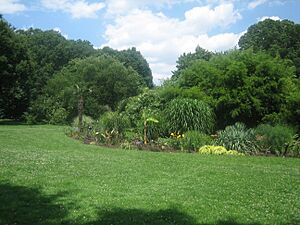
In its early years, BBG held annual "spring inspections" and events like Fall Rose Day. In 1990, scientists at BBG started the New York Metropolitan Flora project to study all plants growing in the New York City area.
BBG began creating new types of magnolias in the 1950s. They developed Magnolia × brooklynensis and Magnolia 'Elizabeth', a yellow magnolia.
The Brooklyn Botanic Garden Herbarium has over 300,000 preserved plant specimens. These help scientists track plant species and study changes in the area's plants. The Brooklyn Botanic Garden Library has many books on gardening and botany for everyone to use.
Community Horticulture
Since 1993, BBG has run the Community Greening program. This program helps neighborhood groups with gardening. It includes the annual Greenest Block in Brooklyn contest, which started in 1994. BBG also hosts Making Brooklyn Bloom, an annual event with workshops.
The Community Greening program also has the Community Garden Alliance and the Street Tree Stewardship program. The NYC Compost Project helps people with composting.
Publications and Online Resources
BBG started publishing a magazine called the Record in 1912. It also began a series of gardening handbooks in 1945. Brooklyn Botanic Garden's Guides to a Greener Planet offer advice on garden design and native plants.
BBG launched its website in 1996. The website has information on events, classes, gardens, and gardening tips. It also has historic photos and an interactive map called CherryWatch, which shows when cherry trees are blooming. The Gardener's Resource Center in the Laboratory Administration Building helps people with gardening questions.
Former BBG Locations
BBG used to operate three other locations. The first was a 223-acre (90 ha) research facility at Kitchawan Preserve in Westchester County, bought in 1956. It opened in 1960. BBG sold most of Kitchawan to Westchester County in 1988.
A second property in Westchester County was the Teatown Lake Reservation, established in 1963. BBG owned part of this land until May 2018.
The Clark Botanic Garden in Albertson, on Long Island, was donated to BBG in 1966. BBG used it as an outreach station. The Clark Botanic Garden had small lakes, a children's garden, and a rock garden. The town of North Hempstead bought Clark Botanic Garden from BBG in 1989.
Membership, Events, and Operations
As of 2023, BBG membership starts at $75 for individuals. Members can attend special events like sunset picnic nights. Each spring, a month-long cherry blossom festival called Hanami is held. This used to end with a weekend celebration called Sakura Matsuri, but this event has not been held since the COVID-19 pandemic.
Other events include the Chile Pepper Festival, held annually since the 1990s, and Lightscape, a light art show at the end of each year.
As of 2019, BBG had an annual operating budget of $23 million. BBG had more than 800,000 visitors each year as of 2015.
See also
 In Spanish: Jardín Botánico de Brooklyn para niños
In Spanish: Jardín Botánico de Brooklyn para niños


